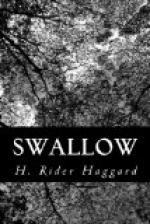As I drew near the spot I thought that I heard a sound of chanting which seemed to come from a little circle of mimosa trees that grew a spear’s throw to my left, of chanting very low and sweet. Wondering who it was that sung thus, and why she sang—for the voice was that of a woman—I crept to the nearest of the trees, keeping in its shadow, and peeped through the branches into the grassy space beyond, to perceive Sihamba crouched in the centre of the circle. She was seated upon a low stone in such fashion that her head and face shone strangely in the moonlight, while her body was hidden in the shadow. Before her, placed upon another stone, stood a large wooden bowl, such as the Kaffirs cut out of the trunk of a tree, spending a month of labour, or more, upon the task, and into this bowl, which I could see was filled with water, for it reflected the moonrays, she was gazing earnestly, and, as she gazed, chanting that low, melancholy song whereof I could not understand the meaning.
Presently Sihamba ceased her singing, and turning from the bowl as though she had seen in it something that frightened her, she covered her eyes with her hands and groaned aloud, muttering words in which the name of Suzanne was mixed up, or of Swallow, as she called her. Now I guessed that Sihamba was practising that magic of which she was said to be so great a mistress, although she denied always that she knew anything of the art. At first I made up my mind to call to her to cease from such wickedness, which, as the Holy Book tells us, is a sin in the eyes of the Lord, and a cause of damnation to those who practise it. But I was curious and longed greatly in my heart to know what it was that Sihamba saw in the bowl, and what it had to do with my daughter Suzanne. So I changed my mind, thereby making myself a partaker of the sin, and coming forward said instead:
“What is it that you do here by night, in this solitary place, Sihamba?”
Now although, as I suppose, she had neither seen nor heard me, for I came up from behind her, Sihamba did not start or cry out as any other woman would have done; she did not even turn to look at me as she answered in a clear and steady voice:
“Now while she is still a girl I read the fate of Swallow and of those who love her according to my lore, O mother of Swallow. Look, I read it there.”
I looked and saw that the large bowl was filled to the brim with pure water. At the bottom of it lay some white sand, and on the sand were placed five pieces of broken looking-glass, all of which had been filed carefully to a round shape. The largest of these pieces was of the size of a crown of English money. This lay in the exact centre of the bowl. Above it and almost touching its edge, was another piece the size of a half-crown, then to the right and left at a little distance, two more pieces of the size of a shilling, and below, but some way off, where the bowl began to curve, a very small piece not larger than a six-penny bit.




